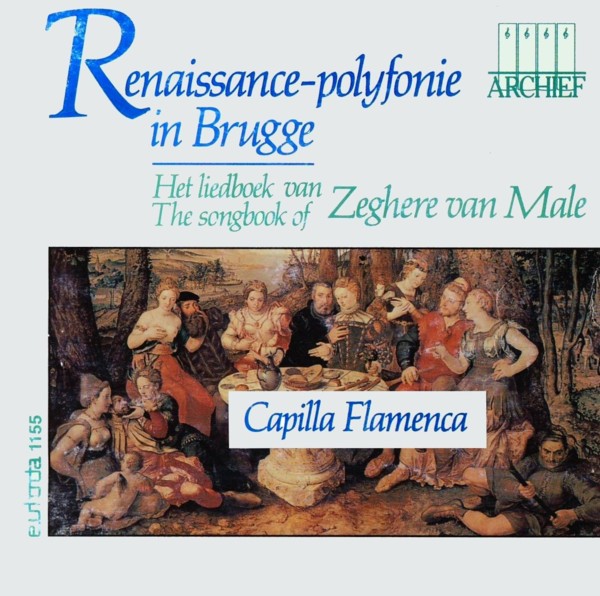Het liedboek van Zeghere van Male, 1542
Renaissance-Polyfonie in Brugge / Capilla Flamenca

medieval.org
capilla.be
Eufoda 1155
1993
Geesteljike Muziek
1. Preludium [0:56]
2. Laus Deo [1:25]
3. Benedictus APPENZELLER. Muse Jovis [5:34]
4. Sanctus uit Missa 'C'est doncq par moy' [6:31]
5. JOSQUIN. O Intemerata [3:25]
Liederen uit de Lage Landen
6. Pierre DE LA RUE · Hans JUDENKÜNIG. Mijn hert
altijt [2:25]
7. Pierre DE LA RUE. Mijn hert altijt [3:57]
8. Duo zonder name [2:29]
9. Den zin verblyt [1:05]
10. Ghequest ben ic [2:09]
11. Gheerkin de HONDT. Het was my wel te vooren [1:40]
Franse Chansons
12. Chantons, sonnons trompettes [1:56]
13. Claudin de SERMISY. Jouissance vous donneray [2:41]
14. Johannes de HOLLANDE. O cueur ingrat [1:51]
15. Adriaan WILLAERT. Mon petit cueur [1:50]
16. Forseulement [2:45]
17. JOSQUIN · Luis de NARVÁEZ. Mille regretz [2:25]
18. Jean MOUTON. Resjoïssés vous [1:46]
19. Ninot LE PETIT. C'est doncq par moy [2:04]
20. Benedictus APPENZELLER. Qui l'ara, l'ara [1:28]
Dansmuziek
21. Pavane [1:43]
22. Basse Danche [1:45]
Vroeg bekende madrigalen in de Lage Landen
Philippe VERDELOT
23. Ognun si duol' [1:22]
24. Se l'ardor [2:29]
25. Donna leggiadra [2:42]
Capilla Flamenca
Els Delsupehe · soprano, portative organ, crumhorn
Paul Gerhardt Adam · countertenor
Edmund Brownless · tenor
Dirk Snellings · bass, Renaissance gamba, crumhorn
Carine Rinkes · Renaissance block-flute, dulcian, crumhorn
Eugeen Schreurs · Renaissance gamba, crumhorn
Hans Michael Koch · Renaissance lute
Paul van Loey · Renaissance block-flute
This recording attempts to show
something of the scope of musical life in late fifteenth- and early
sixteenth-century Bruges. The liner notes emphasize the importance of
printing in making music available to a wider spectrum of people,
especially the middle class. The songbook from which selections are
taken is a hand-compiled, richly illuminated work in four volumes of
more than three hundred pages each, made in 1542 for the Bruges yarn,
linen and fabric merchant, Zeghere van Male. All tracks make use of at
least one instrument. — medieval.org
This songbook, which was compiled in 1542, is one of the few to have
been preserved in Flanders, and is an exceptionally fine example of the
16th century musical activity in middle class society.
It is characterized by a varied content that has both an international
and a local orientation. It contains religious music such as masses and
motets as well as profane music represented by the Dutch polyphonous
song, the French chanson and the Italian madrigal as well instrumental
music. The music is partly composed by well-known international
composers (Willaert, Josquin, Mouton), and partly by local composers
(Lupus, Gheerkin, Lapperdy, Raedt).
The close attention and care given to the book, is clearly an
indication of high self-esteem of its proud owner, Zeghere van Male,
merchant, husband, father of sixteen children, politician, writer, and
cultivated bourgeois.
For this recording, an earnest attempt has been made to suggest the
musical landscape of Bruges anno 1542: historical 'impossible' sound
combinations were therefore left out. When choosing the
instrumentation, we usually envisioned a middle class music society.
Not only voices but also all kinds of instruments were used, especially
instruments that were very popular in the middle of the 16th century,
such as the lute, the (viola da gamba and the recorder. For the
pronunciation, we opted for a reconstruction of the mid-16th century
idiom, whereby regional variants are often responsible for a kind of
surprise-effect. — capilla.be
